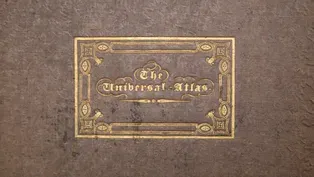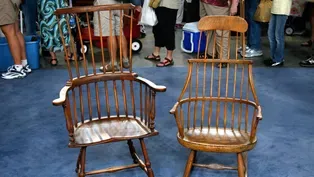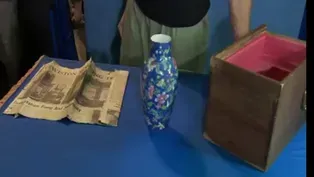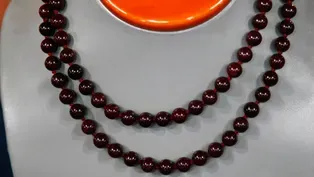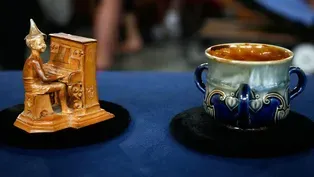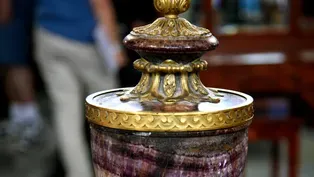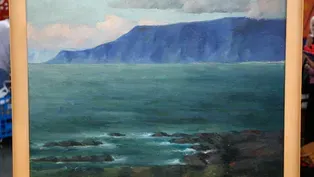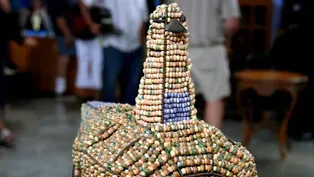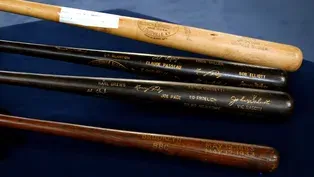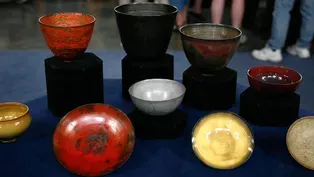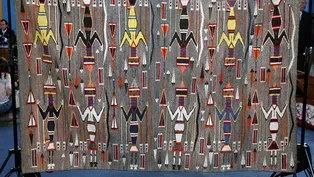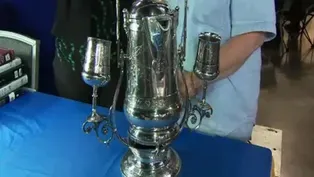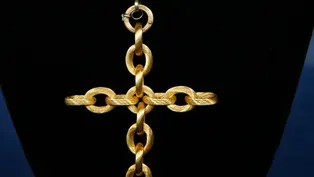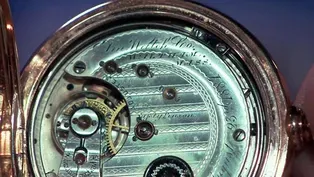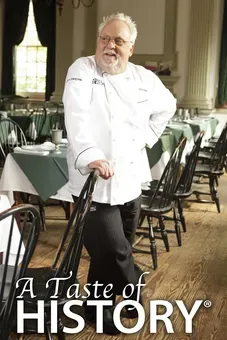

Vintage Spokane, Hour 2
Season 25 Episode 9 | 52m 26sVideo has Closed Captions
Journey to the Pacific Northwest to learn if the values held strong or headed south!
Journey back to the Pacific Northwest to discover antique and vintage finds like a Jón Stefánsson landscape oil, a Lonny Frey pro baseball collection, and a Rolex Bubbleback watch. Have their values held strong or headed south since 2007?
Problems with Closed Captions? Closed Captioning Feedback
Problems with Closed Captions? Closed Captioning Feedback
Funding for ANTIQUES ROADSHOW is provided by Ancestry and American Cruise Lines. Additional funding is provided by public television viewers.

Vintage Spokane, Hour 2
Season 25 Episode 9 | 52m 26sVideo has Closed Captions
Journey back to the Pacific Northwest to discover antique and vintage finds like a Jón Stefánsson landscape oil, a Lonny Frey pro baseball collection, and a Rolex Bubbleback watch. Have their values held strong or headed south since 2007?
Problems with Closed Captions? Closed Captioning Feedback
How to Watch Antiques Roadshow
Antiques Roadshow is available to stream on pbs.org and the free PBS App, available on iPhone, Apple TV, Android TV, Android smartphones, Amazon Fire TV, Amazon Fire Tablet, Roku, Samsung Smart TV, and Vizio.
Buy Now

ANTIQUES ROADSHOW 2025 Tour!
Enter now for a chance to win free tickets to ANTIQUES ROADSHOW's 2025 Tour! Plus, see which cities we're headed to!Providing Support for PBS.org
Learn Moreabout PBS online sponsorship♪ ♪ WOMAN: My aunt thought they were junk and didn't want them and threw them in a trash can out back.
MAN: I had it was since I was 28, I'm now 68.
That's a long time to... (chuckling): A long time.
It's an old bird.
We're both old birds.
Holy smokes!
(laughs) ♪ ♪ CORAL PEÑA: "Antiques Roadshow" visited the Lilac City, Spokane, back in 2007, when fans came from far and wide to find out more about their cherished possessions.
14 years later, how are this colorful collection and other intriguing items faring in today's market?
Let's find out in part two of "Vintage Spokane."
So, Trudy, who made the pottery you brought here today?
Well, it was made by Gertrud and Otto Natzler.
And Gertrud threw the pots.
She did beautiful work in clay.
And Otto was very innovative, as you can see, with his glazing.
This was my great- uncle's collection.
He started collecting in 1940s up until, through the '60s.
So you said there were altogether, there were ten pieces originally?
There were originally.
Nine have survived.
Yes-- my uncle was meticulous in keeping records about his art.
He had a very eclectic art collection.
And he had correspondence with Otto Natzler and responses, books from them.
I have the purchase date, what he purchased it for, the item number on the pottery.
Well, Otto was pretty meticulous in his own right...
Yes.
...labeling every piece that he made.
What happened with art pottery, up to about World War I-- there were hundreds of potteries in America making decorative ware.
After World War I, that pretty much ended.
The companies that stayed in business, like Roseville and Rookwood, started making more and more production ware, because it cost too much money for artists to decorate pieces.
And the hand-done individual pieces, like what you've got, started to become the work of studios or colleges.
We go through this period of the Depression where it got even worse.
And all of a sudden, the Natzlers, who fled in the '30s and came to America, started producing these fabulous pots.
And Gertrud would throw the pots-- paper-thin, perfect proportions-- and Otto was a glaze experimenter and kept playing with glazes and writing down formulae and developing these sensational glazes.
So they almost single-handedly resuscitated the pottery movement in the United States.
And they set the path for all the people that came after them during the Mid-century art movement.
And when most people think of Modernism, they think about paintings, furniture, lighting.
There are really very few ceramic masters who were operating in America at that time.
I do want to show one thing, by the way, is this mark on this one piece here.
Sometimes it'll say "G & O Natzler" on the earlier pieces.
But they all, one way or another, in black, say "Natzler" across the bottom.
What did your uncle pay for all these pieces?
Oh, golly.
I think the first piece he had, which is not included in this set, he paid seven dollars for in 1940.
Uh-huh.
But the prices range from very, very modest amounts...
I think I saw $20 on the price sheet?
$20, yes.
And the most expensive was about $140.
Yes.
The one closest to you, that is a small plate in a crater glaze, which is one of their most popular and salable glazes.
The market for these, by the way, is off the charts for Natzler right now.
That little guy right there is worth between $1,500 and $2,000.
Wow.
That would be an auction estimate.
It could go for more than that.
This one, about the same.
It's a little bigger, but the glaze isn't quite as good.
This has a terrific orange flambé.
Estimate this one for between, say, $3,500 and $4,500.
This bowl closest to me, it's a closed bowl form, also about $3,500 to $4,500.
This is called a melt-fissure glaze, this one in the center.
This is lovely.
In fact, I've never seen this glaze before.
I would say $5,000 to $7,500 at auction, but it might be more like $7,000 to $10,000 because of the rarity of that glaze.
This startling sang de boeuf, blood of ox piece, closest to you, which is just scintillating and full of rich, fresh arterial blood color, as they call it, a lovely piece, also, I would estimate that for $4,500 to $6,500.
This also, a melt-fissure piece with some ox blood running through it, is more like either a $7,000 to $10,000 piece or $8,000 to $12,000.
This lovely metallic black one, which is full of gunmetal shavings, I would estimate that for between $10,000 to $15,000.
And finally, we'll share the inside of this one here, too.
This is good through and through, this piece.
A nice, orange, crater-glazed piece.
I would estimate that for $8,000 to $12,000.
And these, again, are conservative prices.
Well, isn't that exciting?
He really loved their work, and he got great joy from it.
MAN: This is special to me, because when I grew up, I saw this bird in front of a shop in Texas and they would always decorating.
He'd have ribbons or wreaths or hats and you name it, all throughout the year.
How long have you had it?
It was a gift.
I worked for a design firm, and my boss knew that I liked this bird.
So he arranged somehow to get it, and he bought it for me.
And at a birthday, he gave me this ribbon and I followed it.
And it went through woods and everything and finally ended up in a greenhouse, and there was my bird.
I've had it was since I was 28, I'm now 68.
That's a long time to... (chuckling): A long time.
It's an old bird-- we're both old birds.
It is signed, and we ran across an article in "National Geographic" that featured artists from Finland, and we looked him up, and he's won all kinds of prizes.
And that's-- this is especially-- each bead is handmade, and it got so laborious and he became so popular, that they started making the beads for him in a factory.
But he still hand-glazes each ceramic bead, and then he wires it in there.
This artist is, you can see his name right here.
Yeah.
And it's hard to pronounce.
Oh, I can't, I can't.
But it's like Kaipiainen.
Yes.
And he worked for a company in Finland, in Helsinki, that was the Arabia company.
He was considered one of their top artists, so he was given a complete license to make any designs that he wanted.
This is just a wonderful example of his work.
He made things like plates, and vases, and other things.
Right.
But this really shows modern design.
It's all handmade, one bead at a time, and there's just hundreds of beads here.
But it's all on this framework.
If we were going to put a value on for auction, we would probably put an estimate of maybe $10,000 to $15,000.
The problem is, these are the ones that sometimes blow through those record books.
Go, go through?
And, but according to where it's at right now, this market is right around the $10,000 to $15,000 range.
Okay.
He's, he's become kind of a friend.
It sounds funny, but I'm really attached to the bird.
WOMAN: I was at a local estate sale, and there was a big pile of jewelry, and right in the middle of it was this watch.
So I picked it up and carried it with me through the sale, and when we were leaving, um, the man said, "That will be ten dollars."
And I said, "Okay, thank you."
And I walked out and put it away and...
Looked at it later and thought it was kind of special 'cause it says "Rolex."
But I didn't know if it was real or not.
And have you had it appraised before?
My husband took it to a local appraisal fair.
Somebody said to him that he would give him $800 for it.
And my husband called, and I said, "No, I think we'll keep it."
Well, to give you a little history on the watch, then.
It is genuine.
Oh.
It was made by the Rolex Watch Company in Geneva, Switzerland.
They first launched this model in 1931.
This, for example, was made around the early 1940s.
It's in a 14-karat- gold case.
It's nicknamed the "Bubbleback."
It was the first-ever good automatic wristwatch, and one of the first watches that made Rolex famous.
It winds by the movement of your wrist-- very clever.
The reason it's called a Bubbleback is... it has this very bulbous-size case.
It's a very thick watch to allow for the rotor to keep it running.
Now, there are particular collectors that like these watches, um, principally because it's such a famous design that they made.
The bracelet itself is not original on it.
Often with these type of watches, they were sold on leather straps, and that when bracelets became very fashionable-- mostly around the 1950s and '60s-- then people would put associated bracelets onto them.
Doesn't alter the value of the watch at all.
Oh, all right.
I have to say, I think whenever you take it to get appraised and someone wants to buy it from you rather than appraising it, you have to be a little cautious.
Your red flags have to start flying.
But you definitely made the right decision.
Oh, wonderful.
For a watch like this, in this type of condition, I think realistically, and at auction purposes, you'd be looking around $4,000.
(gasps) Wow!
That is great.
WOMAN: Well, I brought in this urn that my father got from a friend of his.
The story goes, my father's friend brought this home from France after the war.
Supposedly, it had been shot in several places.
And he was just downsizing and gave it to my father, who was also over there in France.
And we've had it for about 40 years now.
What we've got here is a decorative urn that was probably manufactured in France from an English stone.
This stone that we've got here is typically called Blue John, which a lot of people haven't heard of.
No.
Largely because it was mined in England.
Oh.
And now the deposits of Blue John are pretty much gone.
Oh, really?
Because it was so popular, that they went in and took out everything that there was to be had, practically.
Really?
And you can see the striations of color throughout the body of it.
It sort of looks like amethyst.
Um...
Which is what we thought it was.
Yeah, exactly, Blue John, it has a lot of color variety.
Sometimes it's more gray or black or blue, hence the name Blue John.
Mm-hmm.
Sometimes it's called Derby Spar.
Oh.
Because it was mined near Derby, England.
The mines are still there and they can pull out Blue John from these mines, but in very, very small pieces.
Only big enough to make jewelry, really.
So what you have here is a really gigantic piece of Blue John.
Wow.
It's in these gilt-bronze mounts that are very well done.
This is a decorative urn.
Probably would have been one of a pair.
It doesn't open up.
No.
It doesn't do anything but sit there and be pretty.
You mentioned that it had been shot.
That, that's the story.
Now, and I think... That's the story.
If we turn it around a little bit, we can sort of see that it's had a little bit of a hard life.
That's a good war story-- that bullets caused these, these damages.
But if we look all down in here, where we have this chunk that's out of it.
Mm-hmm.
Up here, we've got this big hole knocked in it.
Could have been bullets.
Who knows?
Maybe it just had a hard life.
Maybe.
Maybe somebody just knocked it over.
It's got these big chunks in this join, which make it a little bit unstable.
But it's still a really beautiful thing.
And if we look down here...
Yes.
...we have a mark... Mm-hmm.
...that I think is the mark of the retailer.
It's Beaudouin-Massin.
They may have made it or they may have just been the people who sold it.
Okay.
These pieces of Blue John are very, very collectible.
A piece like this in this condition, I'd estimate it conservatively for auction at about $3,000 to $5,000.
Really?
Yeah.
And I think... Wow, that's amazing.
If it were in perfect shape, I think you'd be looking at easily more in the range of $20,000.
Oh, my.
Maybe even more.
But it could be restored by someone who works with stone.
And do something that would make it look good and be a bit more stable.
Yes.
(laughing) The cost might be $500, $1,000 maybe, but when you're looking at enhancing the value of it by at least that much, if not more, it might be something that you want to consider.
We will consider that.
I think you saw my face when you walked in with the doll, because I thought it was an absolutely amazing doll.
And I wouldn't hesitate putting $1,500 on this doll.
Oh, really?
Yeah.
Well, my grand...
Even though you told me it was one of the ugliest dolls you ever saw.
(laughing) It used-- when I was little, it used...
I'd see it and it was scary.
(both laughing) Well, there are a lot of people in the collecting field that would not think it was scary.
This furniture was made after World War II when America experienced this wonderful burst of enthusiasm and this incredible look towards the future.
And I think this table is worth about $3,500.
I think it's a wonderful representation of Mid-century Modern, and thank you for bringing it to the Antiques Roadshow.
Thank you.
These were called French crystal regulators.
They were made around 1900 or slightly before.
They were sold in very high-level jewelry stores.
Today, at auction, this is probably $900 to $1,200 in value.
Very good.
Thank you so much.
It was a gift from a friend, um, and I do know that his grandfather purchased it here in a jewelry store in Spokane for about 60 bucks, in clearance, in the late '60s.
Do you know who made the watch?
I thought it was a company by the name of Williams.
I hate to disappoint you; it's not Williams.
It's not Williams?
It's not Williams.
It's the American Waltham Watch Company of Waltham, Massachusetts.
Okay.
All right?
We look for the front, you see a classic porcelain dial with Roman numerals.
And we open up the main cover, and then we open up the dust cover, and you can see right up on top, it says "American Waltham Watch Company."
This watch was made sometime around the late 1800s, 1887.
Now, you know, what does this watch do?
Um, it chimes, actually.
It chimes, like, the hour and then, like, the quarter-hour, or tenth of an hour, or something like that.
Right, it's a repeater.
A repeater.
Waltham made very, very few repeating watches, and this one is in like-new condition in a case that's absolutely perfect.
Let's just show everybody how you activate the repeater.
You take this slide over here, you pull it down... (watch chiming) And then you can hear it chiming.
It's just extra-crisp.
You can see all the engine turning is perfect.
Any thoughts on the price?
Um, probably a couple of hundred bucks.
I mean, you see them in pawn shops all the time.
So I, I wouldn't know.
Get out of here.
I, I really, I wouldn't know.
(laughs) We figure this is probably, on the conservative side, at auction, $6,000 to $8,000.
Holy smokes!
(laughs) I'm going to have to give that watch back!
(both laughing) You're a good man.
Thanks.
MAN: Well, it was printed in 1836.
And my father acquired it about 50 years ago, when we lived in western New York, outside Buffalo.
It was handed down to me a couple of years ago.
It was something that I marveled at as a child, looking at the old historic maps and finding things like Transylvania.
Yes, well, I agree with you.
It is a, it is a marvelous thing.
"Burr's Atlas" of 1836.
It's, as it says, a universal atlas, and it was a world atlas.
It followed on a pattern of 18th-century atlases.
And this, of course, was a period of intense exploration of the world and the broadening of the world.
And it's great that this interest should come to America as, you know, 60 years on after it emerges as a nation.
Mm-hmm, certainly.
And here's Burr publishing this book in 1836.
And the beauty of this atlas is that it's hand-colored in outline; and because these maps have remained in the volume, the colors remain absolutely vivid.
Mm-hmm.
And no wonder it enthralled you as a child, that's right.
Yeah, right, exactly.
You've got a variety of them.
There's-- I think it's 63 maps in there, isn't it?
I believe so, yes.
Yeah, 63 maps.
Well, here's Africa, for example.
And look at all that white space for the unexplored regions.
This is a long time before Africa was carved up and colonialized.
Mm-hmm.
But it was the start of it.
And then, of, uh, more local interest here in Spokane, of course, is the map of Oregon Territory.
And all this area, I think, was Oregon Territory.
Mm-hmm.
Again, you see this very bright outline color.
Would these be purchased for academic purposes, or in a sitting room, parlor situation, library?
You've hit the nail on the head.
Okay.
Private library at home, teaching at schools.
Mm-hmm.
Some of the better academies and places like Harvard and Yale and Princeton, the universities, would have had this.
And this is where Burr would have made his money as an author and atlas-maker.
Mm-hmm, excellent, excellent.
It's become quite sought after.
Oh.
The attrition to atlases like this has been quite severe because a number of maps have been taken out and framed.
Uh-huh.
And the beauty of this, of course, is, you've got them all here.
Right.
In terms of condition, it may look a bit of a problem, but actually, this original grained cloth, which was a deeper purple, as you see... Mm-hmm.
...could be revived, and then, a conservator binder could put a good back on that.
Okay.
There's a lot of interest in cartography at the moment.
Uh-huh.
And particularly in complete atlases.
This would bear an auction estimate in the region of $15,000 to $20,000.
Whoa!
Yeah.
(laughs) That's a lot more than my dad paid for it.
Yes, I'm sure it is.
A good investment.
Yeah.
To think I almost didn't bring it.
Really?
(chuckles) WOMAN: They belonged to my aunt's mother-in-law that had come over from England, and when she died, about 50 years ago, my aunt thought they were junk and didn't want them, and threw them in a trash can out back, and my mom was there, saw that, and asked her, "Well, can I have them, then?"
And she said, "Sure," and Mom dug them out of the trash can and has had them all these years.
Mom wanted to know what these were for years.
Unfortunately, she died several years ago and never did find out, so coming to the Roadshow today, I'm feeling like I'm kind of fulfilling Mom's dream of finding out what these were.
Getting a little closer to the truth.
Yes.
Yes.
Okay.
Now, looking at these, would you think that they were made by the same factory?
Probably not.
Do you know?
They were.
They're both made by Doulton Lambeth, which is an English factory that did this type of work in the 1860s through the 1880s, well into the 1900s, when they became Royal Doulton.
Now, there were two distinct types of wares.
There were the commercial wares, which were the sort of almost assembly line... You know, you glaze it, you mold it, that sort of thing.
And this represents that.
It has a nice glaze of blue and green.
Very attractive.
On the bottom here, we have the marks, Doulton Lambeth.
Mold marks, painter's marks, and it would be considered your ordinary piece of Doulton Lambeth.
Over here-- and this is the funny one, isn't it?
Yeah.
Little guy pounding away on a piano.
The interesting thing about this is the mark that you find right here on the side of the piano, which is "G.T."
in a monogram.
That stands for a gentleman by the name of George Tinworth.
George Tinworth is considered really pretty much the father of what became Royal Doulton figurines.
He did a lot of figurines of mice and of frogs, and very, very interesting terra-cotta figural groups that are just absolutely loved by collectors worldwide.
So we have a George Tinworth mark here, and a different mark on the bottom.
And that's why you said it looks so different.
Right.
These are the ones that the true artists did.
Rather than assembly-line material like this one, these are the ones where they're really truly sculpture.
And he was probably one of the most important sculptors for a pottery in the late 19th century, so that having been said, an example like this, even with a little damage you have here to the brim of his hat, you'd want to insure it for about $2,500.
Oh, my gosh.
(laughs) That's amazing.
And this one's worth maybe about $100.
Wow.
Wow.
In insurance.
Look at the difference between the two.
Oh, my gosh.
He's making beautiful music over there.
(laughs): That's awesome.
Now, what if his hat had not been broken?
You would probably want to insure it for more around $3,800 or $4,000.
Really?
So it does make a difference.
Wow.
You're making me tear up.
(laughs) This is a rug that I inherited from my grandmother.
She was a collector of Native American art.
And, as I understand it, she acquired this rug in the '30s.
I have done no further research on it.
What you have here is a great weaving made by the Navajo Indians in New Mexico and Arizona.
This particular weaving depicts figures called Navajo Yei figures, and that's spelled Y-E-I.
And the Navajo Yei is a deity figure.
When the Yei figures appear to the Navajo people, they are performing a nine-day healing ceremony.
The Yei figures appear after the first hard frost in the late fall, early winter, usually in December sometime.
When the weaver weaves a weaving like this, it's woven on a vertical upright loom.
The weaving is woven... ...this way.
The Navajo weavers use no patterns.
These are designs that she creates as she weaves.
As she's working.
Yes.
Okay.
How interesting.
She has used hand-spun wool yarns.
This a natural brown yarn; this is a natural cream yarn, and they've carded the two colors together.
And they've made this sort of heathery gray-brown color out of these two colors here.
The other colors are aniline dyes.
And the figures are heavily embellished with jewelry and clothing, their headgear.
He's holding in his hands the ribboned streamers that contain eagle feathers.
And then these are eagle feathers here.
These double bars, they're little guardian figures, and they're spaced throughout the weaving for protection.
The weaving is from the 1930s, from the Four Corners area of the Navajo reservation.
If you were to have it appraised for insurance purposes... Uh-huh.
...for replacement cost, this weaving could easily be appraised at $12,000 to $15,000.
Oh, my goodness.
APPRAISER: Coppola e Toppo is a brother and sister team.
In the 1940s, they created this type of beaded jewelry.
Wow.
And these pieces were extremely popular and extremely pricey when they were made.
I would say this set, because it's so wearable today, $1,500 to $1,800 on any marketplace.
You don't see Coppola e Toppo... That's wonderful.
Here's a Gallé vase and this is enameled decoration.
And then this is an acid-etched kind of stippled background.
It's got all the qualities of a gorgeous piece of glass.
I would say auction estimate would be $3,000 to $4,000.
Okay.
Does that work for you?
Yeah, that's great.
Okay, all right, very good.
Thank you very much.
Thanks.
APPRAISER: It's a model 66 Winchester, rifle.
MAN: That's just what I thought.
By the serial number, you can tell it was made in 1877.
Really?
The great thing about it, it has all this original patina on the brass, but it has a lot of the original blue finish on the barrel.
The value in this condition would be $7,500.
$7,500.
Seven... seven...?
Wow!
$7,500.
Well, there's gonna be some happy people.
Well, good.
That's wonderful.
Yeah.
That's great.
Just continue to take care of it and enjoy it.
Oh, I will.
This was an article that ran in the 1961 "Lewiston Morning" newspaper, and it has a small story about my husband's grandparents, and they happened to acquire this piece when they were in China in the 1920s.
And you'll notice that this particular vase is in the article.
Supposedly it's from the Ming Dynasty.
Well, I'll tell you, it's not Ming, and there's a clear indication as to why it's not Ming.
First of all, there is a reign mark on the bottom of the piece that says "Qianlong."
The Qianlong emperor was in the Qing Dynasty, which postdated the Ming.
But there's also an added twist to this.
This is actually a turn-of-the-century copy of a Qianlong piece.
This is done in the Republic of China period, which was from the fall of the Qing Dynasty in 1911 to the founding of the People's Republic in 1949.
About ten years ago, pieces like this were selling for about $800 to $1,200.
However, in the current market, due to the participation of all of the new mainland China buyers, it would have a presale estimate of $5,000 to $7,000.
$5,000 to $7,000?
Yes.
Oh, my goodness!
When my parents bought their first home, my mother wanted to fill it with American, early American antiques.
And when was, when was this?
1950, 1951.
1950.
And where, was it right here, in Spokane?
No, it was in Los Angeles.
I wanted to know their value, because I want to insure them properly.
My father always warned me that they were valuable, but that's all he ever said.
Okay, that's it.
No numbers or anything?
No.
First of all, I love Windsor chairs.
I do, too.
Okay.
You love them, too?
That's great.
I have seven at home.
Seven of them.
Well, which one of these do you think is the better chair?
I don't know, I mean...
Which would you pick?
I would think this one's older.
But I wouldn't know.
That's older, okay, all right.
But you don't have any idea of value comparison?
No.
Okay.
Let me just quickly say, this is a lovely oval seat, probably New England.
You always look underneath here at the wood, and that looks like white pine.
It suggests it's New England because they used a lot of white pine there.
Mm-hmm.
Nice chair that has, that's a rocker.
But it's not going to be that valuable, okay?
Mm-hmm.
This little rocker could be insured for about $600.
If it had paint, it'd be more valuable.
I'm going to slide this rocker back and come over to this one.
It's a Rhode Island Windsor from about 1760 to 1770.
Oh, cool.
Okay?
And what's neat about Rhode Island Windsors is that there are a group of them with this profile-- do you see this curved profile?
Mm-hmm.
This is the crest rail, these, usually hickory or ash-- because they're bendable-- spindles... Mm-hmm.
...come down to this little pillow on top of the seat rail.
Mm-hmm.
You see how it's echoed, this S-curve is also echoed here?
Mm-hmm.
Now, the arms-- I'm going to tip it forward just a little bit.
What kind of wood do you think that is?
It's a light-colored wood, very hard.
I don't know.
Maple?
Maple?
Maple.
It's a wood that they used a lot in Rhode Island.
They used hardwoods.
This seat, it looks like it's chestnut.
That makes sense for Rhode Island.
And the wonderful seat with this-- let me just show you this.
See that little flair?
Mm-hmm.
Now, that was something that you see a lot on English chairs.
Oh, mm-hmm.
That wonderful little flair that gives it that extra, extra curve.
And this fits the bottom quite nicely, right?
Yes, it's very comfortable.
Very comfortable, right?
And one of the really nice things about the chair is that the feet are original.
Mm-hmm.
These feet usually get cut off, they turn them into rocker chairs, like the other chair was turned into a rocker.
Original feet.
It's...
I couldn't believe it.
I looked very carefully to see.
Uh-huh.
Because they're often replaced.
You need to check that, and that takes away about 80% of the value.
Oh!
But these feet are good.
So it's a really, really nice chair.
Mm-hmm.
Now, there's one thing that it used to have that it doesn't have anymore.
It's missing paint.
Paint?
It lost its paint.
Almost every Windsor was painted.
Oh, I didn't know that.
If you look at the bottom... Oh!
Do you see this?
It has the original wash and then the white, the white paint.
So this is what stayed, it's like the DNA... Oh!
...that remains after they took away that surface, probably a hundred years ago.
Amazing.
Now, for insurance purposes, you could easily put this chair for about $16,000.
$16,000?
$16,000, yes.
Wow.
(chuckles) 16!
I mean, just for this chair.
So that's quite a difference.
Wow.
That's a lot.
That's a lot.
For a chair.
For a chair, it is a lot for a chair, and it should be protected.
Would you like to sit in it?
Sure.
Have a seat-- do you mind if I sit in this, this?
No.
And I can look up at you.
Okay.
Now, if the white paint were still on there... Mm-hmm.
...it would probably be, kind of on a bad day, $60,000.
Wow.
Now, your mom didn't take the paint off, so you can't blame her.
No.
No, she didn't.
WOMAN: I went to a Goodwill on the Oregon coast.
APPRAISER: Okay.
And for $20, I...
I knew they were special when I saw them.
And then you went further.
You had them tested?
Yes.
I went from... many gemologists, and I must have-- on the Oregon coast alone, probably ten to 15.
No kidding?
A total of over, over 20... Did anybody tell you what they were?
Most of them didn't have a clue.
This gemologist would say, "Go to that gemologist."
Oh, he'd... And I'd go to the next.
"And this gemologist is better."
Anybody offer to buy them?
Um... nobody offered to buy them.
Okay.
Because I, um, I didn't want to sell them-- they knew.
What do you think they are?
Well, one lady committed herself, and she said she believed they were old rubies.
At first, they'd hold them and they'd go, "They're not real."
Okay.
And then they'd say... "Wait a second, wait a second!"
"Well, maybe they are."
Yeah, "Well, maybe they are," you know, and most of the time-- because I had them in my little hot hand and I'd warm them up, and they'd be warm-- they'd say, "Oh, they're beads," you know?
But then, after that, she said that they're worth around $10,000, you know, but I'm going, "Oh, my gosh," and that was cool, but she said she wouldn't commit herself, so she sent me to another big mucky-muck.
She said he was a gemologist and he had a big gallery...
Okay.
...with things, pieces that were, like, $30,000 and $100,000.
You went to a high-class store.
Yeah, so it looked really good.
And what did he tell you?
And he took them in his hands, and he, at first, said the same thing-- "Oh, they're not real," and I said, "Yes, they are."
He said the color didn't look real.
Now, what we have here is a stone tester.
This thing does not lie.
Cool.
If it's not real, it's going to go up into that area right around here.
And this also tells you what type of stones it is.
Wow.
Rubies are corundum.
Sapphires are also corundum.
I tested quite a few of your stones.
Yeah.
Now, watch what happens.
Nothing.
Okay.
Nothing.
Nothing.
(laughing): Is that good?
We're going all around it.
So... Now, and I looked at the stones through the loupe and everything else.
Yeah?
I'm sad to tell you that they're not real.
No.
Yeah.
They're some sort of composite.
Really!
They might be a plastic.
You're kidding.
See?
I'm not kidding you.
He put an hour and a half on those things.
I'm telling you, and if you have this tested in the lab, it's going to cost you about $200 to have the stones tested, and they're going to tell you that it's not real.
And did you see the pieces you can see through and everything?
Everything.
Weird.
I'm sad, I'm sad to tell you that, I wish they were real, because if they were real, a ruby necklace like this would be worth $100,000.
(laughs) Now it's worth-- good costume jewelry...
So it's worth ten bucks or 20 bucks.
That's what it is.
Strange, very strange.
So I'm sorry to tell you that, but we had a good time with them.
Yeah, we had a great time.
(chuckles) I'm glad you came in.
Yes, it's good to meet you.
Okay.
(laughs) I bought them at an antique shop probably about 25 years ago.
I think I paid between $125 and $150 for the camel.
Uh-huh.
And around $75 for the monkey.
Well, you've done a little research on these.
A little.
And tell us what you found.
Um, found a picture of the camel from a museum site, I believe, in Switzerland.
Uh-huh.
The monkey I didn't find.
Mm-hmm, so you found this and you identified the maker and the year, right?
Steiff, and the one that I saw was 1908.
1908, yeah.
Now, what did you want me to tell you about it?
He had some bad hole damage.
Mm-hmm.
I did a little bit of repair.
There's a lot that I didn't repair.
I want to know how that helps or hurts.
I see.
I added these tassels.
This is original.
This is original.
Yeah.
These are original.
Came with it, yeah, yeah.
These little gold ones were added.
Okay.
These kinds of repairs don't really affect the value-- they actually help stabilize the toy.
I generally would leave small holes alone.
But anything where you have a large hole does not hurt the value.
The tassels-- definitely leave them, they add to it.
If anybody was upset with them, they could remove them.
You're absolutely right about the age, 1908, and it is Steiff.
And we've had Steiff on this show before.
But generally, what we see are Steiff teddy bears.
But the non-bear-type Steiff is also very, very desirable.
And particularly when you get into this kind of size.
This is probably the largest of the camels that they made in that era, with the cast-iron wheels, and basically, he's in pretty darn good condition.
Most Steiff animals do have buttons in their ear.
Right.
Everybody's looking for the button.
And you can see on the monkey, there was a hole where he did have a button.
I'm not so sure that he had a button in his ear.
There's no remnant of it, and I'm not 100% sure that they put buttons in the largest animals like this.
I would say on today's market at auction-- and also, I think a retail dealer would probably ask about the same-- around $4,000 to $5,000.
Really?
All right.
So, uh...
I mean, I think it was a good buy for about $100... Is that together or the camel?
Oh, no, that's just the camel.
Okay.
The monkey-- I think they called him Jocko the Monkey-- he's also quite early, quite large, with the very large arms.
He has some condition problems.
Pretty bald, yes.
He's losing some, getting bald here on the back.
But I would say he'd be in the $1,200 to $1,500 range.
Oh, that's nice.
So I think you did very well.
I think they go great together.
Yeah.
And I'm really glad you brought them in.
Thank you so much.
Thank you for bringing them in.
APPRAISER: It is a Daum lamp, and they were a major French factory.
This is a boudoir lamp, a small lamp.
We do have one problem, though.
Mm-hmm.
And that is the top, as you see there.
Oh.
Yeah, yeah.
Where that's buffed off a little bit.
Well, that hurts the lamp a little bit.
Mm-hmm.
Even with this damage on it, it's still $1,500 to $2,000.
Oh, my gosh, wow!
Now, if it had the little tip on it, it would have been a few hundred dollars more.
Yeah.
I bought it, I think, in about '53, '54.
Played it for probably 15 years out in the clubs and shows, wherever I could play it.
It's a Gretsch Country Club, they called it.
And this color was called Cadillac green.
Yes.
And I don't think anybody else was selling green guitars in that part of the '50s, so you, you must have been kind of a, kind of a styling guy, you know?
You must have been kind of a, kind of a fashionable character.
I like the color.
Yeah.
And I like the way it sounded, it's a beautiful sound.
Yeah-- in a retail environment, this Gretsch would sell for about $4,000 today, maybe a little more.
Good.
WOMAN: I have a friend that is a Disney collector, and he had one of the artists coming over to his house that night, and I wanted his autograph.
So I took this frame over there, and the artist signed it, and drew all these little characters on the frame.
And one of them kind of stood out because I had no idea who he was.
And that was the gremlin right here.
And, like, a week later, I went to the swap meet, and there was a man carrying this little doll around with him.
So I followed him around and he got back to his booth and he laid the doll down.
And so I immediately picked it up, purchased it for $20, and then went home and looked at the two characters and said, "I think they're the same."
So later I got the "Gremlin" book, and I also had the artist sign that.
Gremlin was one of those characters who appeared around World War II.
There was supposed to actually be a film, a movie made out of "Gremlin."
Really?
But it never happened.
I know him from cartoons.
Oh?
And really having any sort of memorabilia from "Gremlin" is very, very unusual.
So this is a wonderful little archive that you have.
You've got stuff that's worth about $2,000 to $3,000.
No kidding!
Congratulations!
Thank you so very much.
MAN: Well, this painting hung in my dad's office.
It was given to him in Iceland.
He was a golf pro at the course there, and he was going from Iceland back to Denmark to teach golf, and the board of directors gave him this among other gifts.
And how long had he been in Iceland?
A couple of years there.
But in Europe overall, 18 years, playing golf and teaching golf.
You were kind enough to bring in this letter that he wrote as he was heading towards Denmark from Iceland.
Yes.
And I just wanted to quote a little bit because it mentions the paintings.
"Boy, oh, boy, "wait until you see the gifts which were presented to me: "a painting by Iceland's leading artist, a picture of Thingvellir."
So here we have it.
So you were a little mystified as to who the artist might be.
Yeah, I don't know the exact name.
I see the signature.
The name is Jón "Stevenson."
Ah.
Stefánsson-- I'm not sure of the pronunciation.
Uh-huh.
This letter, which is dated 1935, probably indicates that this painting might be from around the same time, and it was interesting.
In the '30s, the art community in Iceland kind of did a split.
There was a younger, more radical group that embraced less traditional subject matter and approaches to painting.
But Stefánsson and his group promoted painting landscape, and going the more traditional route.
Hm.
The artist was born in 1881 and he did study abroad in Denmark and France and he really was one of the leading proponents of landscape painting in Iceland.
I know that somebody gave you an interesting comment once about the value of this painting.
My aunt's niece, who lives in Iceland, when my aunt died, she came over to settle the estate.
And I invited her to come to my house and she came in through the basement, and I had a couple of paintings hanging on the wall, and her mouth dropped and she went towards the wall and said, "You're rich."
And I said, "I am?
How rich?"
She says, "100,000 kronas, maybe."
And I says, "Well, what's that?"
And she says, "Maybe a new car."
(laughs): I don't know.
Well, I don't know how much a kroner is, but I would say, if you were to sell this at auction, you might expect to get $30,000 to $60,000.
Oh, wow, that's fantastic.
WOMAN: It was given by my great-grandfather to my great-grandmother on their wedding day as a wedding present for the bride.
And, uh, they were married January 1, 1872.
She passed it down to her oldest daughter, which was my grandmother, and my grandmother willed it to me.
I see.
Well, it's a lovely piece.
The necklace is 14-karat yellow gold.
Okay.
And it was made in the early 1870s.
And the box is also an important part of the story.
And if we open up the box here, what we will see is that the inside of the box, it says "Tiffany and Company..." Mm-hmm.
"Union Square."
Now, Tiffany is an important retailer and manufacturer of jewelry in America in the late 19th century and certainly for the 20th century.
But it's at this time period that Tiffany is really seating the foundation of the business... Mm-hmm.
...that will later become the major jewelry retailer that we know them as today.
Yes.
They were still a dry goods dealer, as well.
They dealt in stationery... Oh, mm-hmm.
Pots and pans, jewelry, et cetera.
Now, they were not a jewelry manufacturer at this time, except for basic wedding rings and small pieces.
So chances are, this piece was perhaps made overseas or it was something that they in turn subcontracted.
They don't really start becoming a full-time manufacturer until the late 1800s.
Mm-hmm.
What's also interesting about this necklace to me is that it also speaks very much of the era.
Here we have the cross and the chain, and it's what's called a reeded chain.
Mm-hmm.
These are hollow links that are machine-made.
Also, what I like about this is that it has a lot of opulence.
It has visual weight.
Yes.
Even though the piece does not weigh a lot.
And this is also in part due to the fact that even though the Gold Rush was in 1849, there's still not as much gold in the marketplace yet.
And so the idea was to take a small amount of material and make a very large-looking ensemble.
Mm-hmm.
The other important thing to remember is that because this piece is not signed, you always will need to keep it with the box.
Because if the box and the piece become separated... Mm-hmm.
...then nobody's going to know that the piece is actually Tiffany.
Right.
Do you have any idea of the value of the piece?
Not really.
I had it appraised about 20 years ago, and they told me it was only worth the scrap weight of gold.
Well, it's certainly worth more than the scrap rate these days.
Mm-hmm.
At auction, one would expect to gain anywhere between $3,000 and $4,000.
Mm-hmm.
For insurance purposes, it should probably be insured for about $9,000.
Oh, that much?
Thank you.
You're welcome.
WOMAN: Well, my parents bought a home in, like, '71 or '72, and it had an old garage, and they tore it down.
And my brother and I found it buried in the dirt under the frame of the garage.
And we put it up in our tree fort for a while.
And then my dad found out we had it and took it.
And what did you think it was?
Some old lady picture.
It's a pretty special lady picture.
Is it?
It is.
The original mold for a tile is done by a sculptor.
The modeler, or the sculptor, his name was Isaac Broome.
He moved from abroad to the province of Quebec, and then he came down here to this country, to the Trenton area, to work for the Ott and Brewer company.
And he did many pieces for them, some beautiful pieces of Parian ware.
And he was so successful that some of his pieces won prizes at the Centennial Exposition in Philadelphia in 1876.
So there's something huge and gorgeous called the Baseball Vase, which became so famous, and that was Isaac Broome.
Okay.
So he worked for Ott and Brewer, and he worked for several other companies in the New Jersey and Pennsylvania area.
And he became known as a tile modeler.
And these tiles were done at the end of the 19th century, when most of the tiles looked like the style, very classical figures.
And Parthenia, which is her name here, she was a goddess.
She was a nymph and a naiad.
So she was one of the water goddesses, and he did very few of these.
Oh, serious.
(chuckles) All of them unsigned.
But we do know that it is by Isaac Broome, because there is a signed copy in the Trenton Museum.
Oh, wow.
What's so special about her, as well, many tiles being done at that time had these golden-amber glazes or green glazes, and she is in this lovely gray-blue, which is very rare and also something that we associate at this point with Isaac Broome's work.
He was particularly fond of this color.
Okay.
These would have been made to set in a wall, perhaps over a fireplace, also in a half-wall, like a dado, and probably surrounded by plainer tiles or just floral tiles.
But she would have been the star of that panel.
(murmurs) And this beautiful frame that you have, this lovely brass frame, was added later.
It is crazed, like a lot of pieces at that time.
Right.
That happens in the firing.
Has a couple of little pockmarks here, but these are not bad.
It's really in beautiful condition for having found it...
Buried in the dirt.
(laughs) I would probably put a price on it of about $1,000 to $1,200.
Okay, oh, very good, yeah, it's pretty...
Pretty good old lady picture, huh?
Pretty great old lady picture, indeed.
Thank you.
I've heard of Babe Ruth, I've heard of Lou Gehrig.
I've heard of Joe DiMaggio.
But you have to tell me, who's Lonny Frey?
Well, he's still living, he's 97 years old.
He started out as a shortstop at age 22 with Brooklyn.
How do you know all this?
Because he's my dad.
Ah!
And he still talks baseball to me once in a while.
So he played how many years in the Big Leagues?
14 years.
He actually played for all three New York teams.
He's the last surviving ballplayer to have done that.
He spent most of his career with Cincinnati, and that was where he probably had his best years.
He was an All-Star for three years.
Right, and he played in two World Series with Cincinnati, and at the end of his career, he played with the Yankees in a World Series.
Wow.
We've got this bat here.
This is from 1933, this is the start of his career.
Right.
He was there from '33 to '36.
Yeah.
Not a great situation.
They were fifth, sixth place.
Much better when he went to Cincinnati.
Exactly.
Because when he was in Cincinnati-- if I recall correctly, 1938-- he got to play behind Johnny Vander Meer during his two consecutive no-hitters.
That's exactly right.
And that was one of his all-time career thrills.
And he got this Joe Jackson store model bat during the '30s when he was playing for Cinci.
Even though he was in Cincinnati for two World Series...
Right.
...I think he saved the best for last.
We've got 1947, World Champions, Yankees.
Who was his roommate?
Yogi Berra.
And what did he think of Yogi?
Well, they're really good friends.
(chuckles) But he roomed with Yogi because Yogi ate a lot of pasta and he was losing a lot of weight.
Uh-huh.
And they needed somebody to get him to eat regular meals, steak and potatoes and so forth.
So '47, he's at the end, he was the oldest player in the league in '47 and '48... That's right.
...when he finished up with the Giants.
Right.
Let's take a look at everything for prices.
This is the bat that the Brooklyn Dodgers would have given your dad in honor of their Golden Jubilee, 50 years in baseball, and the value on this, auction estimate would be $1,000 to $1,500.
Now, this bat was given to your dad because he was on the World Championship New York Yankees in 1947.
The value on that is $2,000 to $3,000 that I'd put as an auction estimate.
This is your dad's All-Star bat from 1941.
Now, these bats were only given out to the players and the coaches and the manager of the All-Star teams.
Mm-hmm.
And they have these fabulous facsimile signatures on there.
You can see your father right here, Lonny Frey.
Right.
And the value on these bats generally, $2,000 to $3,000 auction estimate.
The Joe Jackson bat is probably worth about $3,000 to $4,000.
This watch was given for winning the World Series, but also because they set the American League record that year with 19 straight wins.
This watch is probably worth about $3,000 to $4,000.
The Mets watch is probably about $1,000 to $2,000, but the ring is the real big winner-- I mean, a '47 World Series ring is as good as it gets: Yankees and Dodgers, the epitome of New York, that's $15,000 to $20,000.
Oh, my Lord.
So you add all these things up and you get a grand total of probably about $25,000 to $30,000.
That's wonderful, and...
This is stuff that we've handed down and will hand down in the family.
But it's nice to know, because we should insure it or do something like that.
If you were going to insure all of this...
Yes.
I'd place an insurance value of about $50,000.
That's amazing.
PEÑA: And now it's time for the "Roadshow" Feedback Booth.
And I found out my little barrette here is 14-karat gold, it's worth about $75, but they didn't know the maker's mark on there.
I got to meet Leigh Keno!
(giggles) And we have this Victorian chair that was worth about $200.
We had a great time.
We had a great time!
This is a mug which I firmly told them was not worth anything.
And I just wanted to know a good way to clean it.
And he told me it was worth something, but there isn't a good way to clean it, so I have to take better care of it.
(chuckles) And this is my friend Buddha.
We came expecting him to not be worth anything, but he turned out to be worth $400, $600.
And now my grandpa won't be using it for target practice!
Today, I have brought two head vases from my collection of head vases which were made in the '50s.
And this is the largest size.
This is the next-largest size.
And although they weren't valued anywhere near I thought they would be, I just had a fantastic time, and I really enjoyed the "Antiques Roadshow" experience.
And I hope I get to come back again.
We came with our canister set from Berlin, 40 years old, and my husband broke the lid of this one in the line.
No, she did it.
No, no, he did it.
No, she did it!
Okay, anyway, we had a good time.
(laughing) Goodbye!
Yeah, we really had a good time-- thank you.
PEÑA: Thanks for watching.
See you next time on "Antiques Roadshow."
Appraisal: 1836 David Burr Universal Atlas
Video has Closed Captions
Appraisal: 1836 David Burr Universal Atlas (3m 31s)
Appraisal: 18th C. Windsor Chair & 19th C. Windsor Rocker
Video has Closed Captions
Appraisal: 18th C. Windsor Chair & 19th C. Windsor Rocker (3m 23s)
Appraisal: Bill Justice Illustrations & Gremlin Memorabilia
Video has Closed Captions
Appraisal: Bill Justice Illustrations & Gremlin Memorabilia (1m 33s)
Appraisal: Chinese Republic Period Porcelain Vase
Video has Closed Captions
Appraisal: Chinese Republic Period Porcelain Vase (1m 36s)
Appraisal: Cornelis van Leemputten Oil Painting, ca. 1885
Video has Closed Captions
Appraisal: Cornelis van Leemputten Oil Painting, ca. 1885 (1m 3s)
Appraisal: Costume Beaded Necklace, ca. 1910
Video has Closed Captions
Appraisal: Costume Beaded Necklace, ca. 1910 (3m 20s)
Appraisal: Doulton Lambeth Pottery, ca. 1885
Video has Closed Captions
Appraisal: Doulton Lambeth Pottery, ca. 1885 (2m 52s)
Appraisal: French Blue John Urn, ca. 1910
Video has Closed Captions
Appraisal: French Blue John Urn, ca. 1910 (3m)
Appraisal: Isaac Broome Tile Panel, ca. 1885
Video has Closed Captions
Appraisal: Isaac Broome Tile Panel, ca. 1885 (3m 2s)
Appraisal: Jón Stefánsson Oil Painting, ca. 1930
Video has Closed Captions
Appraisal: Jón Stefánsson Oil Painting, ca. 1930 (2m 41s)
Appraisal: Kaipiainen Beaded Bird Sculpture, ca. 1960
Video has Closed Captions
Appraisal: Kaipiainen Beaded Bird Sculpture, ca. 1960 (2m 26s)
Appraisal: Lonny Frey Professional Baseball Collection
Video has Closed Captions
Appraisal: Lonny Frey Professional Baseball Collection (3m 36s)
Appraisal: Mid-20th C. Gertrud & Otto Natzler Pottery
Video has Closed Captions
Appraisal: Mid-20th C. Gertrud & Otto Natzler Pottery (4m 13s)
Appraisal: Navajo Yei Weaving, ca. 1935
Video has Closed Captions
Appraisal: Navajo Yei Weaving, ca. 1935 (2m 19s)
Appraisal: Reed & Barton Silverplate Pitcher, ca. 1880
Video has Closed Captions
Appraisal: Reed & Barton Silverplate Pitcher, ca. 1880 (35s)
Appraisal: Rolex "Bubbleback" Watch, ca. 1940
Video has Closed Captions
Appraisal: Rolex "Bubbleback" Watch, ca. 1940 (2m 16s)
Appraisal: Steiff Camel & Monkey, ca. 1908
Video has Closed Captions
Appraisal: Steiff Camel & Monkey, ca. 1908 (3m)
Appraisal: Tiffany & Co. Gold Necklace, ca. 1870
Video has Closed Captions
Appraisal: Tiffany & Co. Gold Necklace, ca. 1870 (2m 52s)
Appraisal: Waltham Watch Co. Repeater, ca. 1887
Video has Closed Captions
Appraisal: Waltham Watch Co. Repeater, ca. 1887 (1m 52s)
Providing Support for PBS.org
Learn Moreabout PBS online sponsorshipSupport for PBS provided by:
Funding for ANTIQUES ROADSHOW is provided by Ancestry and American Cruise Lines. Additional funding is provided by public television viewers.


